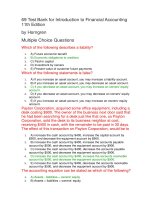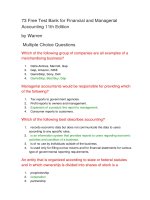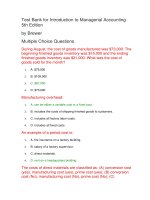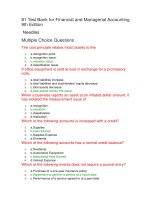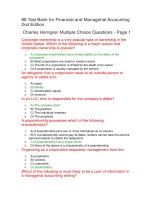Test bank for introduction to managerial accounting 5th edition
Bạn đang xem bản rút gọn của tài liệu. Xem và tải ngay bản đầy đủ của tài liệu tại đây (66.29 KB, 12 trang )
Test Bank for Introduction to Managerial Accounting 5th
Edition
Multiple Choice Questions
Walton Manufacturing Company gathered the following data for
the month: Cost of goods sold: $35,000; Sales: $89,000;
selling expenses: $16,000; Administrative expenses:
$21,000. How much net operating income will be reported
for the period?
1.
A. $54,000
2.
B. $17,000
3.
C. $52,000
4.
D. Cannot be determined.
Manufacturing overhead:
1.
A. can be either a variable cost or a fixed cost.
2.
B. includes the costs of shipping finished goods to customers.
3.
C. includes all factory labor costs.
4.
D. includes all fixed costs.
An opportunity cost is:
1.
A. the difference in total costs which results from selecting one alternative instead of
another.
2.
B. the benefit forgone by selecting one alternative instead of another.
3.
C. a cost which may be saved by not adopting an alternative.
4.
D. a cost which may be shifted to the future with little or no effect on current operations.
A lawnmower manufacturer computed a cost per unit of $53 by
adding together last month's direct labor, direct materials,
and manufacturing overhead and dividing that total by the
10,000 units produced last month. (There were no
beginning or ending inventories.) If 9,000 units are going
to be manufactured this month, we would expect that the:
1.
A. cost per unit will remain the same.
2.
B. cost per unit will decrease.
3.
C. direction of change in unit costs cannot be determined.
4.
D. cost per unit will increase.
Transportation costs incurred by a manufacturing company to
ship its product to its customers would be classified as
which of the following?
1.
A. Product cost
2.
B. Manufacturing overhead
3.
C. Period cost
4.
D. Administrative cost
Which of the following IS a characteristic of financial
accounting?
1.
A. not mandatory
2.
B. must follow GAAP
3.
C. emphasis on relevance of data, rather than precision
4.
D. both A and C above
Within the relevant range, the difference between variable costs
and fixed costs is:
1.
A. variable costs per unit fluctuate and fixed costs per unit remain constant.
2.
B. variable costs per unit are constant and fixed costs per unit fluctuate.
3.
C. both total variable costs and total fixed costs are constant.
4.
D. both total variable costs and total fixed costs fluctuate.
Which two terms below describe the wages paid to security
guards that monitor a factory 24 hours a day?
1.
A. variable cost and direct cost
2.
B. fixed cost and direct cost
3.
C. variable cost and indirect cost
4.
D. fixed cost and indirect cost
The plans of management are expressed formally in:
1.
A. the annual report to shareholders.
2.
B. Form 10-Q submitted to the Securities and Exchange Commission.
3.
C. performance reports.
4.
D. budgets.
The costs of direct materials are classified as: (A) conversion
cost (yes), manufacturing cost (yes), prime cost (yes); (B)
conversion cost (No), manufacturing cost (No), prime cost
(No); (C) conversion cost (yes), manufacturing cost (yes),
prime cost (No); (D) conversion cost (No), Manufacturing
cost (Yes), Prime cost (yes)
1.
A. A
2.
B. B
3.
C. C
4.
D. D
The three basic elements of manufacturing cost are direct
materials, direct labor, and:
1.
A. cost of goods manufactured.
2.
B. cost of goods sold.
3.
C. work in process.
4.
D. manufacturing overhead.
Micro Computer Company has set up a toll-free telephone line
for customer inquiries regarding computer hardware
produced by the company. The cost of this toll-free line
would be classified as which of the following?
1.
A. Product cost
2.
B. Manufacturing overhead
3.
C. Direct labor
4.
D. Period cost
Buford Company rents out a small unused portion of its factory
to another company for $1,000 per month. The rental
agreement will expire next month, and rather than renew
the agreement Buford Company is thinking about using
the space itself to store materials. The term to describe
the $1,000 per month is:
1.
A. sunk cost.
2.
B. period cost.
3.
C. opportunity cost.
4.
D. variable cost.
Which terms below correctly describe the cost of the black
paint used to paint the dots on a pair of dice?Variable
cost; Administrative cost: A) Yes, Yes; B)Yes, No; C) No,
Yes; D) No; No respectively.
1.
A. A
2.
B. B
3.
C. C
4.
D. D
Cost of goods manufactured will usually include:A) only costs
incurred during the current period; B)only direct labor and
direct materials costs; C) some costs incurred during the
pirod as well as cost incurred during the current period;
D) some period costs as well as some product costs.
1.
A. A
2.
B. B
3.
C. C
4.
D. D
Prime cost consists of direct materials combined with:
1.
A. direct labor.
2.
B. manufacturing overhead.
3.
C. indirect materials.
4.
D. cost of goods manufactured.
The corporate controller's salary would be considered a(n):
1.
A. manufacturing cost.
2.
B. product cost.
3.
C. administrative cost.
4.
D. selling expense.
Direct materials used in production totaled $330,000. Direct
labor was $415,000 and manufacturing overhead was
$220,000. What were the total manufacturing costs
incurred for the month?
1.
A. $530,000
2.
B. $965,000
3.
C. $745,000
4.
D. $635,000
During August, the cost of goods manufactured was $73,000.
The beginning finished goods inventory was $15,000 and
the ending finished goods inventory was $21,000. What
was the cost of goods sold for the month?
1.
A. $79,000
2.
B. $109,000
3.
C. $67,000
4.
D. $73,000
Haan Inc. is a merchandising company. Last month the
company's cost of goods sold was $66,000. The
company's beginning merchandise inventory was $14,000
and its ending merchandise inventory was $16,000. What
was the total amount of the company's merchandise
purchases for the month?
1.
A. $68,000
2.
B. $96,000
3.
C. $64,000
4.
D. $66,000
In August direct labor was 60% of conversion cost. If the
manufacturing overhead for the month was $54,000 and
the direct materials cost was $34,000, the direct labor cost
was:
1.
A. $36,000
2.
B. $22,667
3.
C. $51,000
4.
D. $81,000
Which one of the following costs should NOT be considered an
indirect cost of serving a particular customer at a Dairy
Queen fast food outlet?
1.
A. the cost of the hamburger patty in the burger they ordered.
2.
B. the wages of the employee who takes the customer's order.
3.
C. the cost of heating and lighting the kitchen.
4.
D. the salary of the outlet's manager.
An example of a period cost is:
1.
A. fire insurance on a factory building.
2.
B. salary of a factory supervisor.
3.
C. direct materials.
4.
D. rent on a headquarters building.
Williams Company's direct labor cost is 25% of its conversion
cost. If the manufacturing overhead for the last period
was $45,000 and the direct materials cost was $25,000,
the direct labor cost was:
1.
A. $15,000
2.
B. $60,000
3.
C. $33,333
4.
D. $20,000
The following costs were incurred in August: Direct materials:
$20,000; Direct labor: $18,000; Manufacturing overhead
$21,000; Selling expenses: $16,000; Administrative
expenses: $21,000.Prime costs during the month totaled:
1.
A. $39,000
2.
B. $59,000
3.
C. $96,000
4.
D. $38,000
During the month of August, direct labor cost totaled $13,000
and direct labor cost was 20% of prime cost. If total
manufacturing costs during August were $88,000, the
manufacturing overhead was:
1.
A. $75,000
2.
B. $23,000
3.
C. $65,000
4.
D. $52,000
The cost of fire insurance for a manufacturing plant is generally
considered to be a:
1.
A. product cost.
2.
B. period cost.
3.
C. variable cost.
4.
D. all of the above.
Green Company's costs for the month of August were as
follows: direct materials, $27,000; direct labor, $34,000;
selling, $14,000; administrative, $12,000; and
manufacturing overhead, $44,000. The beginning work in
process inventory was $16,000 and the ending work in
process inventory was $9,000. What was the cost of
goods manufactured for the month?
1.
A. $105,000
2.
B. $132,000
3.
C. $138,000
4.
D. $112,000
Gabrisch Inc. is a merchandising company. Last month the
company's merchandise purchases totaled $90,000. The
company's beginning merchandise inventory was $13,000
and its ending merchandise inventory was $22,000. What
was the company's cost of goods sold for the month?
1.
A. $90,000
2.
B. $99,000
3.
C. $125,000
4.
D. $81,000
Managerial accounting:
1.
A. has its primary emphasis on the future.
2.
B. is required by regulatory bodies such as the SEC.
3.
C. focuses on the organization as a whole, rather than on the organization's segments.
4.
D. Responses a, b, and c are all correct.
The Lyons Company's cost of goods manufactured was
$120,000 when its sales were $360,000 and its gross
margin was $220,000. If the ending inventory of finished
goods was $30,000, the beginning inventory of finished
goods must have been:
1.
A. $20,000
2.
B. $50,000
3.
C. $110,000
4.
D. $150,000
Each of the following would be classified as variable in terms of
cost behavior except:
1.
A. cost of shipping goods to customers via express mail.
2.
B. sales commissions.
3.
C. plant manager's salary.
4.
D. direct materials.
True - False Questions
Managerial accounting places less emphasis on nonmonetary
data than financial accounting.
1.
True
2.
False
A factory supervisor's salary would be classified as a direct
cost of a unit of product.
1.
True
2.
False
Advertising is a product cost as long as it promotes specific
products.
1.
True
2.
False
A fixed cost is constant per unit of product.
1.
True
2.
False
Differential costs can be either fixed or variable.
1.
True
2.
False
The variable cost per unit is constant and does not depend on
how many units are produced.
1.
True
2.
False
If the finished goods inventory increases between the beginning
and the end of a period, then the cost of goods
manufactured for the period is larger than the cost of
goods sold.
1.
True
2.
False
The cost of goods manufactured for a period is the amount
transferred from work in process inventory to finished
goods inventory during the period.
1.
True
2.
False
Wages paid to production supervisors would be considered
direct labor.
1.
True
2.
False
The cost of shipping parts from a supplier is considered a
product cost.
1.
True
2.
False
Although depreciation is always a period cost in a
merchandising firm, it can be a product cost in a
manufacturing firm.
1.
True
2.
False
Direct material cost combined with manufacturing overhead
cost is known as conversion cost.
1.
True
2.
False
The cost of napkins put on each person's tray at a fast food
restaurant is a fixed cost.
1.
True
2.
False
Managerial accounting is primarily concerned with the
organization as a whole rather than with segments of the
organization.
1.
True
2.
False
The inventory of finished goods on hand at the end of a period
is considered an asset, but inventories of raw materials
and work-in-process are not considered assets until
production is completed.
1.
True
2.
False
Direct labor is a part of both prime cost and conversion cost.
1.
True
2.
False
In a manufacturing firm, all costs are product costs.
1.
True
2.
False

